Do dogs have cannabinoid receptors? Absolutely! And they’re hard at work every day inside your pup’s body.
These receptors are part of a complex network called the endocannabinoid system (ECS), which helps manage mood, rest, digestion, and comfort. It’s nature’s way of keeping your dog’s body in sync from head to tail.
Within the ECS, these cannabinoid receptors connect to the canine brain, nerves, and immune cells. They send signals that support steady energy and overall balance. It’s fascinating science, all designed to help pups feel and function their best.
What Are Cannabinoid Receptors?

Cannabinoid receptors are microscopic signal catchers spread across the body. They’re part of the endocannabinoid system, a natural setup that helps manage mood, rest, appetite, and balance. When these receptors get a signal, they help the body respond and stay steady.
They react to natural compounds called endogenous cannabinoids, like Anandamide (AEA) and 2-Arachidonoylglycerol (2-AG). They also respond to exogenous cannabinoids, like CBD and THC, from outside sources like cannabis plants.
Humans, dogs, and cats all share this system. However, canines often have more receptors in their brain and central nervous systems, so their reaction can be stronger.
Do Dogs Really Have Cannabinoid Receptors?
Yes, dogs really do have cannabinoid receptors, just like people and cats. These receptors are part of the ECS, which helps keep a dog’s body balanced and running well. It’s a built-in network that supports calm moods, smooth movement, and steady comfort.
The two main cannabinoid receptor types are CB1 and CB2. Together, they help manage signals between the brain, nervous, and immune systems. When these signals work properly, pups feel more balanced and ready for anything.
Where Are Cannabinoid Receptors Located in Dogs?
Cannabinoid receptors reside all over a dog’s body, but some areas have more than others. The CB1 type mainly lives in the brain, spinal cord, and nervous system. They help control movement, behavior, and comfort.
The CB2 receptor type is more common in the immune system and peripheral tissues. They help with recovery and balance throughout the body.
Canines tend to have more CB1 receptors in their brainstem as compared to the human brain. This makes them extra sensitive to THC. This also explains why dog owners should choose only pet-safe CBD products for their companions.
What Do the ECS and Cannabinoid Receptors in Dogs Help Regulate?
The endocannabinoid system and its receptors help keep a dog’s body and vital functions steady and balanced. They play a role in managing mood, rest, digestion, and general comfort. This system works behind the scenes every day, keeping your pooch feeling and acting like their usual self.
These endocannabinoid receptors also support immune response, coordination, and emotional stability. When the ECS stays balanced, dogs can handle change more easily and stay calm under stress. It’s one of the body’s smartest ways of staying in tune with itself.
How the Endocannabinoid System Works in Dogs (Naturally)

The canine endocannabinoid system, just like the human ECS, plays a crucial role in maintaining homeostasis or balance in the body. It works through special compounds the body makes on its own. These natural messengers—like Anandamide (AEA), 2-Arachidonoylglycerol (2-AG), and N-Arachidonoyl dopamine (NADA)—connect with CB1 and CB2 receptors to keep things balanced.
When this system runs smoothly, it helps manage comfort, mood, appetite, and coordination. A well-balanced ECS supports steady energy, calm behavior, and overall health. It’s a quiet but powerful system that brings valuable health benefits, helping pups feel their best from the inside out.
How the Endocannabinoid System Works in Dogs (With External Cannabinoids)
When external cannabinoids like CBD enter a dog’s body, they team up with the ECS to support natural balance. Instead of attaching directly to the receptors like THC does, CBD helps the system work more efficiently.
This interaction encourages calmness, relaxation, and comfort without causing any mind-altering effects. It also helps the body maintain a steady rhythm, even during moments of excitement or stress. That’s why CBD made for pets can be a gentle way to support a dog’s overall wellness.
Related Post: Endocannabinoid System in Dogs & Cats: A Complete Overview
CB1 and CB2 Receptors in Dogs – What They Do
CB1 and CB2 receptors are the main players in a dog’s endocannabinoid system. They act like messengers, sending signals that help the body respond and stay balanced. Together, they keep a dog’s mood, comfort, and coordination in check.
CB1 receptors are more active in the brain and central nervous system. Smaller amounts of CB1 also reside in parts of the peripheral nervous system, like nerve endings that connect to organs and tissues. Meanwhile, CB2 works mostly in the immune system and other tissues. Each type has its own job, but both work together to help dogs feel relaxed and well-balanced every day.
CB1 Receptors
CB1 receptors are usually found mainly in a dog’s brain, spine, and nervous system. They help control coordination, behavior, and comfort by managing how signals move between nerve cells. These receptors are especially active in parts of the brain that affect mood and movement.
Because healthy dogs have a higher number of CB1 receptors than humans, they can respond more strongly to certain cannabinoids. That’s why it's recommended that pet owners use only THC-free, vet-approved CBD products. When supported properly, these receptors help pups stay calm and balanced.
CB2 Receptors
CB2 receptors are mostly found in a dog’s immune cells and peripheral organs. They help the body stay balanced by supporting immune responses and recovery. These receptors also play a role in keeping canines relaxed and comfortable after activity or stress.
Unlike CB1, CB2 doesn't affect behavior or coordination. Instead, it works quietly in the background to promote a steady internal state. When the ECS and CB2 receptors work together, they help keep a dog’s overall wellness on track.
Are Dogs Sensitive to Cannabinoids?

Yes, dogs are more sensitive to cannabinoids than humans. They have a higher number of CB1 receptors in their brain. This means even small amounts of THC can affect them strongly. That’s why pet parents should avoid THC-containing products for their furry friends.
Pet-safe CBD products, like those from HolistaPet, are specifically made for dogs and contain no THC. These formulas are gentle, effective, and designed to support calmness and comfort without unwanted effects. Always choose products made for pets to keep your pooch safe and happy.
How CBD Interacts With the Canine ECS
CBD works hand in hand with the endocannabinoid system to help dogs maintain balance. Instead of binding directly to CB1 or CB2 receptors, it influences how these receptors respond to natural signals in the body. This helps the ECS do its job more smoothly.
CBD may also encourage the body to make more of its own endocannabinoid molecules while slowing their breakdown. Many pet CBD products blend CBD with omega oils and plant extracts to support calm behavior and overall vitality.
The Role of Full-Spectrum and Broad-Spectrum CBD in Dogs
Both full-spectrum and broad-spectrum CBD products work with a dog’s endocannabinoid system. However, they differ slightly in what they contain.
Full-spectrum CBD includes a full range of cannabinoids and terpenes. Broad-spectrum CBD, on the flip side, removes THC completely. Research in veterinary medicine has shown that each type can support calm moods, steady comfort, and balanced energy levels.
Many pet owners specifically choose broad-spectrum CBD options because they’re made to enhance wellness without causing unwanted effects. The good news is that HolistaPet offers the broad-spectrum variety, giving pet parents safe, tested choices for their beloved cats and dogs.
Full-spectrum CBD
Full-spectrum CBD includes a variety of natural compounds from the hemp plant, such as cannabinoids and terpenes. It may contain trace amounts of THC, usually less than 0.3%, along with other active elements that work together to support wellness.
While full-spectrum products can offer broad benefits, they aren’t ideal for dogs because of their THC content. Pets process THC differently, and even tiny amounts can cause unwanted effects. That’s why HolistaPet focuses only on THC-free options made for dogs.
Broad-spectrum CBD
Broad-spectrum CBD keeps all the beneficial compounds found in the hemp plant, like cannabinoids and terpenes, but removes THC completely. This means dogs get the supportive effects of multiple plant compounds without any risk of intoxication.
HolistaPet’s broad-spectrum CBD products are THC-free, safe, and carefully tested by third-party labs for purity and strength. They’re crafted to help dogs stay calm, balanced, and comfortable, giving pet parents peace of mind with every drop or treat.
Benefits of Supporting the ECS in Dogs

Supporting your dog’s endocannabinoid system helps them feel balanced and content. A strong ECS means better control over comfort, calmness, and daily wellness. When this system works well, dogs stay more active and in tune with their surroundings. Here’s what a healthy ECS can do:
- Promotes Calm Behavior and Relaxation. Helps pups stay composed during loud noises or new situations.
- Supports Joint and Mobility Comfort. Encourages smoother movement and flexibility.
- Encourages Healthy Appetite and Digestive System. Keeps mealtimes consistent and enjoyable.
- Helps Maintain Balanced Immune Function. Strengthens the body’s natural defenses.
- Aids in Overall Well-Being and Vitality. Keeps healthy dogs happy, steady, and full of life.
How To Choose Safe CBD Products for Dogs
Choosing the right CBD product for your furry friend starts with quality and safety. Look for options made from organic, natural ingredients that are specifically designed for pets. Products should always come with third-party lab test results to confirm purity and strength. Avoid anything that contains THC, artificial flavors, or unknown additives.
Pro tip: HolistaPet offers veterinarian-approved CBD oils, treats, chews, and capsules made from non-GMO, vegan ingredients. Each formula is carefully crafted to support your buddy's balance and comfort while meeting the highest safety standards.
Related Post: CBD Benefits for Dogs & Cats: Maximizing Your Pet’s Wellness
Why Trust HolistaPet for Dog CBD Products
HolistaPet creates clean, cruelty-free, plant-based CBD products made with pets in mind. Each formula uses premium CBD combined with hemp seed oil and other natural ingredients that support balance and comfort. Every product is rigorously tested by independent labs to confirm purity and safety.
Pet parents across the country trust HolistaPet because of its honest approach and consistent results. Many veterinarians recommend these products for pups who need calmness and steady wellness support. We're a brand built on care, science, and transparency.
How To Introduce CBD to Your Dog
Start slow and keep it simple. Begin with a small serving of CBD based on your dog’s size and weight, then adjust as needed. It’s best to watch how your pet responds over a few days before changing the amount.
You can mix CBD oil with food, go for our crunchy treats, or soft chews for easy use. Remember, staying consistent helps the ECS maintain balance. Offer your pup CBD around the same time each day for steady results.
Should Any Dogs Avoid CBD?
Some dogs may need extra care before starting CBD. For example, canine patients with serious health issues or taking prescription medication should only take CBD under a vet’s guidance. Puppies under six months might also need to wait until their bodies are more developed.
Also, if your dog has liver or gastrointestinal tract issues, talk to your veterinarian first. A professional can help decide the right product and serving size. With the right advice, most pups can enjoy the calming and balancing benefits of CBD safely.
FAQs – Cannabinoid Receptors and Dogs
The endocannabinoid system in dogs can sound complex, but it’s easier to understand than it seems. Below are straightforward answers to common questions about how it works and how CBD connects to it.
Do all dogs have cannabinoid receptors?
Yes, all dogs have cannabinoid receptors, specifically CB1 and CB2 types. These receptors form part of the ECS, a network that helps keep their bodies balanced. They play a role in regulating mood, appetite, comfort, and immune response.
CB1 receptors are most active in the brain and nervous system. CB2 receptors work mainly in immune cells and organs. Together, they help the body respond naturally to everyday changes, keeping dogs steady, alert, and comfortable.
Can CBD make my dog high?
No, CBD cannot make your dog high when it’s THC-free and made for pets. CBD works differently from THC. It doesn’t attach to brain receptors in the same way. Instead, it supports the endocannabinoid system to promote calmness and balance.
HolistaPet’s CBD products are specially crafted with broad-spectrum hemp extract. This means they contain zero THC. They’re tested for safety, purity, and consistency, so pets can enjoy the benefits without any psychoactive effects.
How long does CBD take to work in dogs?
Most dogs begin to respond to CBD within 30 to 60 minutes after intake. The timing can vary based on the pet's size, metabolism, and how they take the CBD. Oils usually act faster than treats or chews.
Consistency plays the biggest role in long-term results. Giving CBD around the same time each day helps maintain a steady balance within the endocannabinoid system. Over time, many pet parents notice a calmer, more relaxed, and well-adjusted pooch.
Can I give my dog human CBD oil?
It’s best not to give your dog human CBD oil. Products made for people may contain ingredients, flavorings, or THC levels that aren’t safe for pets. Even small amounts of THC can affect dogs more strongly than humans.
Pet-specific CBD products, like those from HolistaPet, are carefully formulated for dogs’ size and sensitivity. They’re free from harmful additives and contain no THC, making them a safe and reliable option for everyday wellness.
Final Thoughts – The Power of the Canine Endocannabinoid System
Dogs have cannabinoid receptors that help keep their bodies balanced and steady. These receptors work with the ECS to support comfort, calm moods, and daily wellness. It’s a natural process that helps pups handle changes and stay in tune with their environment.
Supporting this system with safe, THC-free CBD can do wonders for dogs' well-being, helping maintain mobility, relaxation, and overall vitality. Discover how HolistaPet’s broad-spectrum CBD products can naturally support your best friend's system and promote everyday wellness.

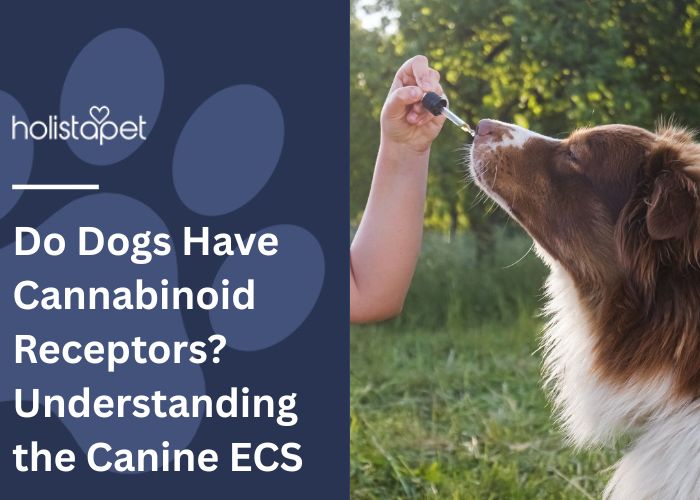
 CBD Oil for Dogs - Fast Acting
CBD Oil for Dogs - Fast Acting
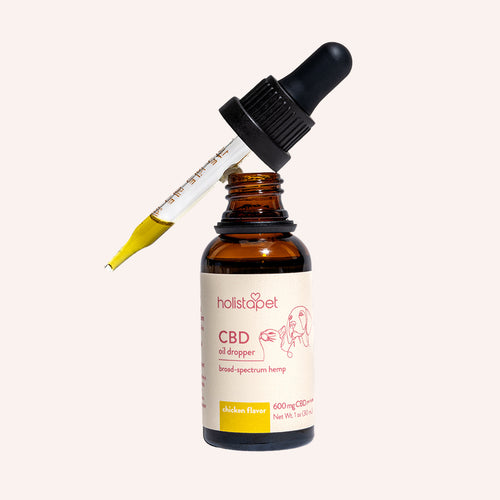 Chicken Flavored CBD Oil For Dogs - Easy Dose
Chicken Flavored CBD Oil For Dogs - Easy Dose
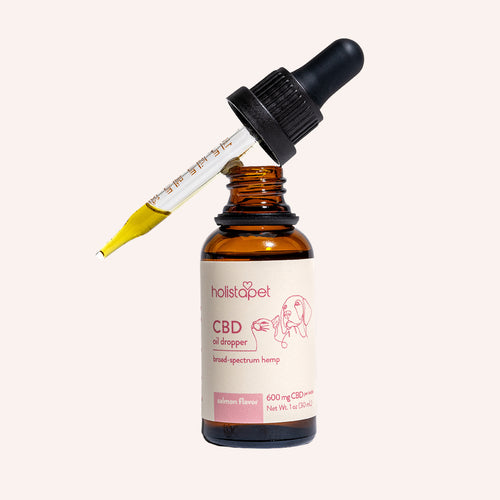 Salmon Flavored CBD Oil For Dogs - Highly Rated
Salmon Flavored CBD Oil For Dogs - Highly Rated
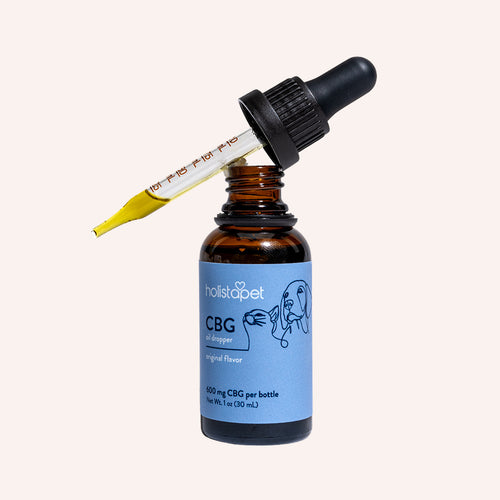 CBG Oil for Dogs and Cats - Loved by Thousands
CBG Oil for Dogs and Cats - Loved by Thousands



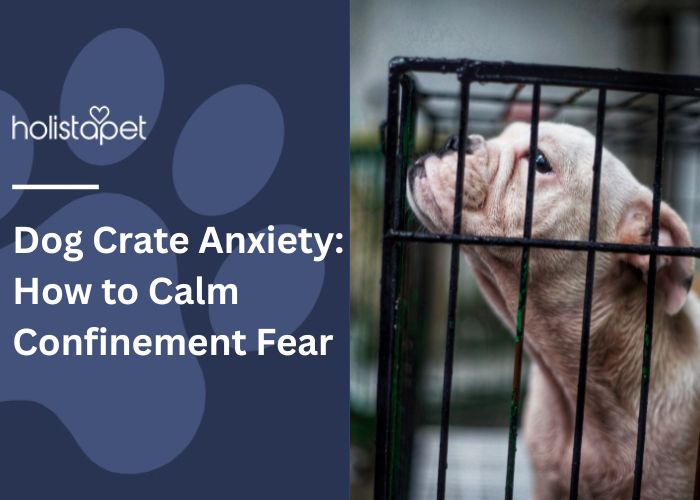

Leave a comment
All comments are moderated before being published.
This site is protected by hCaptcha and the hCaptcha Privacy Policy and Terms of Service apply.